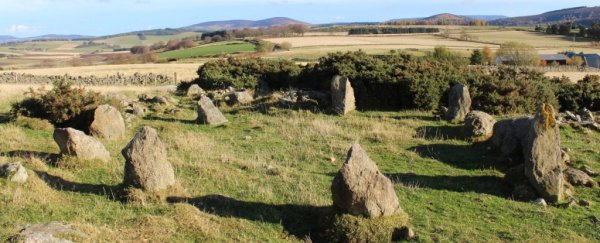Archaeologists investigating a stone circle thought to be thousands of years old in Aberdeenshire, Scotland have been a wee bit chagrined by an unexpected revelation. After reports of the circle's discovery hit the news, a farmer revealed he actually built the monument just decades ago.
The "recumbent stone circle" found on the farm in the parish of Leochel-Cushnie - a rare type of stone circle found only in Scotland and Ireland, named for their one recumbent stone - excited archaeologists because it was unusual even for its kind.
It was noticeably smaller in diameter than other stone circles, with smaller stones, and missing features such as a cairn and kerb stones.
However, there are many variations between stone circles, and they're very difficult to date, so the feature was declared the genuine article, thought to be between 3,500 and 4,500 years old, by Historic Environment Scotland and Aberdeenshire Council's Archaeology Service.
Except now we know the real reason why the Leochel-Cushnie circle is so different from its supposed contemporaries.
As archaeologists were continuing to research the monument, a former owner of the farm came forward to spill his beans all over - and leaving egg on a few faces.
He'd built the circle sometime in the 1990s, he confessed, as a replica of other stone circles that can be found in Scotland.
If you are having an awkward day at work at least you're not that guy who identified a new prehistoric stone circle to the press that now turns out to be about 20 years old. https://t.co/9EGmb9H3pO
— Neil Ackerman (@ncackerman) January 21, 2019
But, according to archaeologist Neil Ackerman of Aberdeenshire Council, the stone circle still has something of value to offer.
"It is obviously disappointing to learn of this development, but it also adds an interesting element to its story," he said.
"That it so closely copies a regional monument type shows the local knowledge, appreciation and engagement with the archaeology of the region by the local community.
"I hope the stones continue to be used and enjoyed - while not ancient it is still in a fantastic location and makes for a great feature in the landscape."
As he explained to Live Science, although replicas aren't uncommon in the area, this one is unusually accurate, which makes it even more fascinating.
Ackerman also notes on Twitter that he doesn't believe the builder's intention was to deceive anyone; rather, the farmer built the circle for his own enjoyment.
And it's a good thing that the council now knows about the circle, since they record all monuments of this type on a database, whether genuinely ancient or a modern replica. This helps avoid similar mistakes in the future.
"We always welcome reports of any new, modern reconstructions of ancient monuments, especially those built with the skill of this stone circle and that reference existing monument types," Ackerman said.
